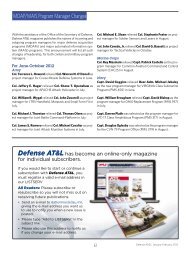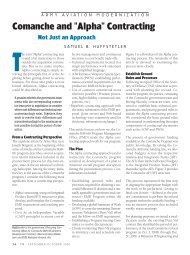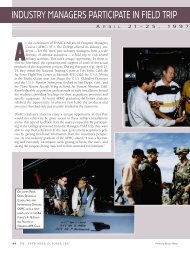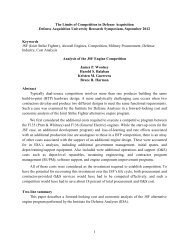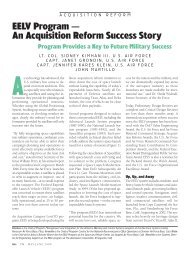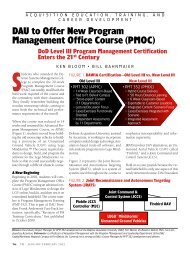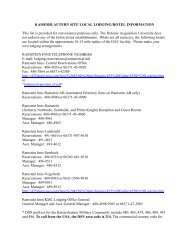Defense ARJ - Defense Acquisition University
Defense ARJ - Defense Acquisition University
Defense ARJ - Defense Acquisition University
Create successful ePaper yourself
Turn your PDF publications into a flip-book with our unique Google optimized e-Paper software.
systeM of systeMs DeVeloPMent<br />
for leadership and sponsorship of joint SoS development efforts should be clearly<br />
articulated in acquisition restructuring plans.<br />
BuDGet: eMPoWerinG tHe sPonsor of a systeM of systeMs<br />
Consolidating SoS development efforts in one organizational structure would<br />
offer the potential to perform limited budget trade-offs among component systems<br />
as priorities changed. However, implementing budget changes that could support<br />
an integrated plan to develop and introduce SoS capabilities would require more<br />
disciplined and flexible resource management than is typically demonstrated in DoD<br />
acquisition programs.<br />
The DAPA Report (2006) reaffirms the existence of fiscal challenges described in<br />
many prior defense acquisition studies. However, most previous surveys focused on<br />
“little a” acquisition issues. Thus, while many prior criticisms addressed legitimate<br />
problems, some of these were symptoms of systemic flaws in the “big A” framework.<br />
The DAPA Report (2006) employs a wider scope to describe how interactions of the<br />
three defense acquisition decision support systems destabilize budgets.<br />
DAPA’s Recommendation on Budget Stability. To improve budget stability, the<br />
DAPA Report (2006) recommends establishing a Stable Program Funding Account<br />
(SPFA) for <strong>Acquisition</strong> Category I (ACAT I) programs. Programs in an SPFA would be<br />
protected against the cascade of unintended consequences flowing from budget reprioritizations.<br />
However, providing such a buffer would depart dramatically from traditional<br />
resource management processes and significantly alter entrenched power relationships.<br />
Acknowledging the political difficulties of instituting such fundamental change<br />
in budgeting, the DAPA Report nonetheless focuses its SPFA recommendation on<br />
programs with the largest capital expenditures. While the Quadrennial <strong>Defense</strong><br />
Review Report offers strong support for the SPFA concept, Congress may be reluctant<br />
to forego its traditional oversight of ACAT I programs (OSD, 2006). Instead, selecting<br />
a “test-bed” program that would derive great benefits from budget stability might<br />
provide a more politically realistic strategy to introduce SPFAs and generate congressional<br />
confidence in the concept. An SoS development effort offers great potential<br />
for such an initiative because the shifting boundaries and goals in SoS component<br />
systems will tend to be especially destabilizing to their budgets.<br />
Budget Problems Specific to SOS Development. The current defense acquisition<br />
system typically rewards managers capable of obligating and expending resources<br />
that were planned years in advance. Changes in resource requirements, either above<br />
or below the appropriated level, are viewed as problems and quickly attract unwelcome<br />
scrutiny. PMs of SoS components will face aggressive oversight and burdensome<br />
inquiries if their budgets demonstrate instabilities.<br />
However, the inherent characteristics of a SoS will likely produce less stable<br />
budgets. Division of programs into individual budget line items tends to emphasize<br />
unitary goals, as opposed to the pluralistic goals of an SoS. Even if a single sponsor<br />
were empowered to balance limited SoS resources across an array of component<br />
systems, this authority would probably be insufficient to compensate “for sudden and<br />
potentially dramatic shifts in system boundaries” that require corresponding resource<br />
shifts (Keating et al., 2003, p. 41). Furthermore, Keating et al. emphasize that budget-<br />
185



